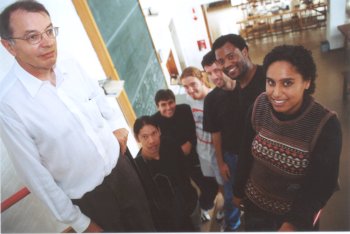Unveiling the universe's genesis
19 May 2002
Hitchhikers to the galaxy: (Left to right) Prof Jean Cleymans and his team of physicists Mark Marais, Mark Horner, Bruce Becker, Spencer Wheaton, Dr Zeblon Vilakazi and Nawahl Razak, represent Africa in an international project to recreate the matter that existed when the Universe was first created.
EIGHT UCT physicists are the sole representatives from Africa and the Southern Hemisphere in an international project to recreate an elusive state of matter believed to have existed at the very creation of the universe, and along the way are trailblazing the next evolutionary dimension of the World Wide Web.
The team, headed by UCT's A-rated nuclear physics pundit, Professor Jean Cleymans, has of November 2001 been an official member of the A Large Ion Collider Experiment (ALICE) of the European Organisation for Nuclear Research (CERN), the world's largest nuclear physics research centre based in Geneva, Switzerland. Over 78 institutes and about 1 000 scientists from 28 countries across the globe form part of the collaboration.
ALICE makes up one experiment of CERN's effort to recreate Quark Gluon Plasma (QGP), sometimes referred to as the "missing state of matter". It is held that QGP existed for about fractions of microseconds after the Big Bang (when familiar particles like protons and neutrons did not exist because it was simply too hot).
The quarks that make up these particles, along with the gluons that bind them together, are believed to have roamed freely in a kind of particle soup known as QGP. CERN is trying to break down the forces that confine the quarks to their particle cages – in the protons and neutrons – to recreate QGP.
It is believed that QGP has been produced in labs, but is yet to be observed. CERN is hoping to push up the energy so high – 300 times higher than has ever been done – so that detection will be possible.
This energy will be created by colliding lead-ions, the heaviest ions to be accelerated, at just a fraction under the speed of light in one of CERN's accelerators. It will then use one of its four detectors to make these particles visible.
The envisaged cost of the project is estimated at about 100-million Swiss francs (more than R650-million). Most of this money will come from west European countries, as well as from Japan, the United States and India, said Cleymans.
One of the problems with the project is the storage and dissemination of the vast amount of data to come out of the accelerators and detectors. "They are setting up what I often call the successor of the World Wide Web – it's the next level," explained Cleymans.
CERN plans to – as it did when it first developed the World Wide Web in the early 1990s – link computers around the world in its 'DataGrid' and then use the expanded bandwidth created by this unique network. A lot of the data coming from CERN – which will be known as Tier Zero in this grid – will be sent to Tier One centres, which in turn will serve as "high throughput analysis farms".
UCT will serve as one of these Tier One centres. "Cape Town at the moment is the only centre in the whole of the African continent and the only one in the whole of the southern hemisphere," said Cleymans.
The Department of Arts, Culture, Science and Technology (DACST) has approved a R200 000 cheque for the project. In addition, UCT's Research Committee has okayed the acquisition of a "PC farm" of about 20 computers, all connected in parallel so that they can operate as one computer for faster throughput.
Funding is also being sought from countries such as Norway and India, who also participate in the collaboration, through bilateral agreements.
Cleymans has also put together a band of UCT researchers who will be pick up – by writing suitable coding and algorithms - some of the signals that would denote that QGP has been formed. The team consists of Dr Zeblon Vilakazi (who worked at CERN as part of his postdoctoral work); Dr Roger Fearick; PhD students Bruce Becker, Mark Horner (the latter will travel to CERN in July for a stint of training), Mark Marais and Spencer Wheaton; and the group's sole Masters student – and woman – Nawahl Razak.
"Our job here is to develop a way to move the data off the accelerators in a very efficient way," said Vilakazi of the band's mission. A theory group will also describe the results that the team obtains from the analysis. "All the building blocks have been put in place," announced Cleymans. "We're now part of a worldwide family of scientists."
 This work is licensed under a Creative Commons Attribution-NoDerivatives 4.0 International License.
This work is licensed under a Creative Commons Attribution-NoDerivatives 4.0 International License.
Please view the republishing articles page for more information.
Related
Alderman Owen Kinahan (1955–2026)
06 Jan 2026
Celebrating UCT’s outstanding Thuthuka results
29 Dec 2025
Looted African belongings must be returned
29 Dec 2025
Republished










